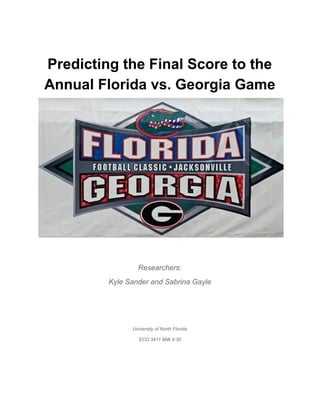
PredictingtheFinalScoretotheAnnualFloridavs
- 20. different than predicted. With that said models like these are used all the time by professionals in the business of sports forecasting and provide a great deal of insight when making educated estimations on competitive outcomes. As two individuals, and Florida Gator fans, who annually enjoy placing cordial bets with friends and family we hope to apply these models to real life next year and prosperously predict the outcome to this yearly clash of college football titans. Bibliography: 1. http://www.ats.ucla.edu/stat/stata/webbooks/reg/chapter2/statareg2.htm 2. www.georgiadogs.com 3. www.gatorzone.com 4. http://www.intellicast.com/Local/History.aspx?location=USFL0228 5. http://onlinestatbook.com/2/estimation/mean.html